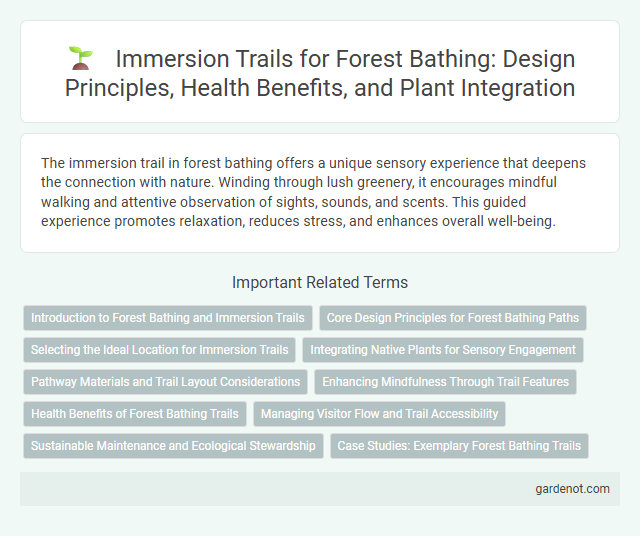The immersion trail in forest bathing offers a unique sensory experience that deepens the connection with nature. Winding through lush greenery, it encourages mindful walking and attentive observation of sights, sounds, and scents. This guided experience promotes relaxation, reduces stress, and enhances overall well-being.
Introduction to Forest Bathing and Immersion Trails
Forest bathing immersion trails offer a carefully designed path that encourages mindful engagement with nature, enhancing mental clarity and reducing stress. These trails guide visitors through diverse ecosystems, promoting sensory awareness and deep relaxation through intentional pauses and observation points. Immersion in natural surroundings on these trails supports emotional well-being by fostering a profound connection with the environment.
Core Design Principles for Forest Bathing Paths
Immersion trails for forest bathing prioritize sensory engagement through natural materials and minimalistic design that fosters deep connection with the environment. Core design principles emphasize seamless integration with the existing landscape, promoting mindfulness by minimizing distractions and encouraging slow, deliberate movement. Path layouts typically incorporate varied textures, gentle contours, and strategically placed resting points to enhance the therapeutic benefits of forest immersion.
Selecting the Ideal Location for Immersion Trails
Selecting the ideal location for an immersion trail requires prioritizing areas with diverse native flora and minimal human disturbance to enhance the forest bathing experience. Sites should feature varied terrain, natural water sources, and ample shade to promote a sense of tranquility and connection with nature. Accessibility and safety are also critical, ensuring visitors can fully engage with the environment while preserving the ecosystem's integrity.
Integrating Native Plants for Sensory Engagement
The immersion trail incorporates a variety of native plants such as sweetgrass, red maple, and wild ginger to enhance sensory engagement through sight, smell, and touch. These plants are strategically placed to provide therapeutic benefits, stimulate mindfulness, and connect visitors deeply with the local ecosystem. Native flora selection ensures biodiversity support while offering an authentic forest bathing experience that promotes physical and mental well-being.
Pathway Materials and Trail Layout Considerations
The forest bathing path incorporates natural materials such as crushed stone, wood chips, and compacted soil to enhance sensory engagement and minimize environmental impact. Trail layout prioritizes gentle curves and varied elevations to promote mindfulness and varied perspectives, while ensuring accessibility and safety for diverse users. Thoughtful integration with the surrounding ecosystem preserves native flora and facilitates immersive, restorative experiences.
Enhancing Mindfulness Through Trail Features
The Forest Bathing Immersion Trail integrates sensory-rich features like textured bark stations, aromatic herb gardens, and strategically placed meditation pods to deepen mindfulness and foster a powerful connection with nature. These designed elements encourage slow, deliberate footsteps and heightened sensory awareness, amplifying stress reduction and cognitive restoration. Visitors report increased presence and emotional balance after engaging fully with the trail's carefully curated natural and interactive components.
Health Benefits of Forest Bathing Trails
Forest bathing trails, also known as immersion trails, enhance mental well-being by reducing stress hormones and boosting mood through prolonged exposure to natural forest environments. These trails promote cardiovascular health by lowering blood pressure and improving heart rate variability, supported by phytoncides emitted by trees. Regular walking along forest bathing paths strengthens immune function and increases overall energy levels, contributing to a holistic approach to physical and psychological health.
Managing Visitor Flow and Trail Accessibility
The Forest bathing path's Immersion trail incorporates strategically placed signage and designated resting spots to manage visitor flow effectively, preventing overcrowding and minimizing environmental impact. Accessibility features include smooth, level pathways and gentle gradients, ensuring that visitors of varying mobility levels can experience the therapeutic benefits of forest immersion. Trail maintenance emphasizes sustainable materials and erosion control to preserve natural habitats while accommodating high visitor numbers.
Sustainable Maintenance and Ecological Stewardship
The immersion trail prioritizes sustainable maintenance through the use of natural materials and minimal-impact construction techniques to preserve local biodiversity. Regular ecological monitoring ensures that foot traffic does not disrupt native plant and animal habitats, supporting long-term ecosystem health. Collaborative stewardship programs engage the community in conservation efforts, reinforcing responsible trail use and habitat restoration.
Case Studies: Exemplary Forest Bathing Trails
The Immersion Trail in Japan's Akasawa Natural Recreation Forest exemplifies the benefits of forest bathing with its carefully curated pathways designed to enhance sensory engagement and relaxation. Studies show that visitors experience significant reductions in stress hormones and improvements in mood after walking this trail surrounded by ancient cedars and diverse plant species. This trail serves as a model for integrating ecological preservation with therapeutic nature experiences in forest bathing design worldwide.
Immersion trail Infographic

 gardenot.com
gardenot.com